Audio editing software allows you to edit and create an audio file. Just like video editing software, Audio editing software is used by audio editors and music mix engineers to delete, rearrange and add audio sections in the audio file.
The software can also offer programs that effectively manipulate the sound of the audio file in several ways.
Audio editing software can edit several types of files such as WAVE, MP3, Windows Media, and MPEG-4.In the current music world, there exist a group of individuals who deal with mixes, editors, and sound engineers and most of them use this software to complete their work.
For beginners, we have a free Audio editing software that can still meet your needs. All you need to do is to read carefully the information we have provided and see what best suit you.
We have tested and researched the best Audio editing software in the market. Our top priority is to enable you to make the right decision when choosing these software.
Here are our top list.
1.Audacity.
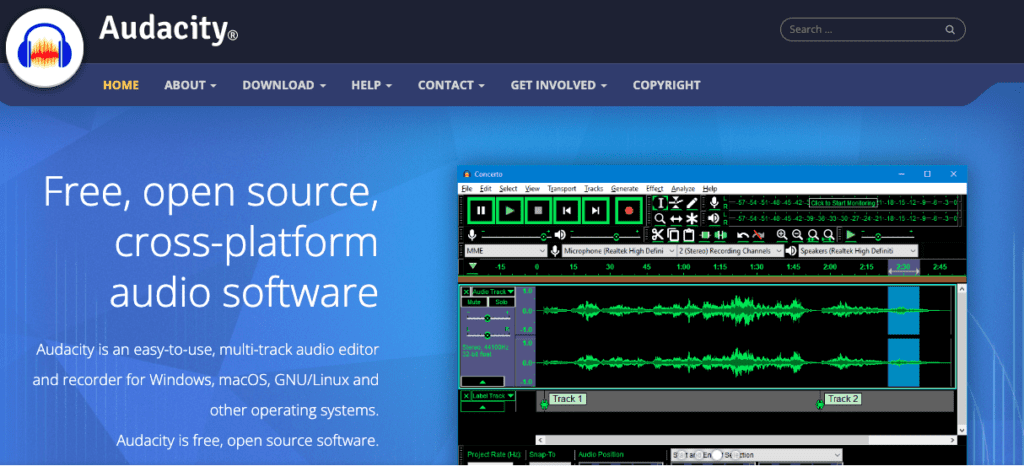
Audacity is an on-premise Audio editing software. Producers can examine LADSPA, LV2, VST, and Audio Unit effects in real-time using the open-source platform.
With Audacity, musicians can export, change, import, generate, and record audio files and soundtracks in a variety of file formats, including WAV, MP3, Ogg Vorbis, AU, AIFF, and FLAC.
Using Audacity, audio engineers can alter the pace or pitch of a soundtrack and produce voiceovers for podcasts or DJ sets.
Musicians can utilize the device toolbar to handle numerous playback or recording devices, cut, copy, or paste audio tracks, and monitor volume.
Additionally, using different keyboard commands as needed, artists can edit soundtracks and eliminate background noises.
Key Features of Audacity.
1.Color Coding.
When working with multiple tracks of editing, switching between them might be a navigation headache.
By designating distinct colors to each waveform based on the instrument being used, it is possible to rapidly resolve any ambiguity.
The wave color sub-menu can be found by simply opening the track menu (the drop-down menu among the controls on the left). Blue, red, green, and black are the options available here for instruments 1 through 4.
2.MIDI.
Since version 2.20, MIDI playback is available in Audacity; however, it is fairly primitive and comes with a large list of limitations.
The majority of instructions use a loopback technique to convert MIDI tracks to audio, thus to get it to function properly, you need an additional device or independent program.
Even while you can cut, copy, and paste portions of MIDI like you would with audio waveforms, there doesn’t seem to be any real method to add new notes or perform proper editing.
While you should explore elsewhere for a suitable MIDI editor because Audacity was never really designed for MIDI work, keep this in mind if you want to aggressively and rapidly cut and paste.
3.Adding audio to video clips.
You don’t even need to use another application to extract the audio stream from a video file if you just want to edit it using Audacity, which will extract the audio for you when you drag and drop the video file onto it.
Please be aware that this won’t function immediately for everyone, as FFmpeg must first be installed.
Those who use Linux will typically already have this installed, while those who use Macs or Windows might need to take additional steps. For further information, consult the guides for Windows, Linux, and macOS.
4.Scrubbing.
Although it’s tough to describe in language, you have certainly seen someone scrub audio in movies.
As the track plays, you can advance and rewind in time by merely dragging your mouse pointer over the play needle. It’s kind of like Quick-play on steroids.
It works well for painstakingly browsing through audio clips and generates amusing fast-forward and slow-motion reverse noises.
5.Quick-play.
With quick-play, you can start the track playing by just clicking anywhere in the play head. You can then move to any point in the track without pausing to alter the beginning location.
If you don’t like this function, you can disable it by right-clicking the play head and selecting Disable Quick-play which is enabled by default.
Dislikes for Audacity
- No pre-recorded audio or sound effects.
- Damaging editing.
2.Reaper.
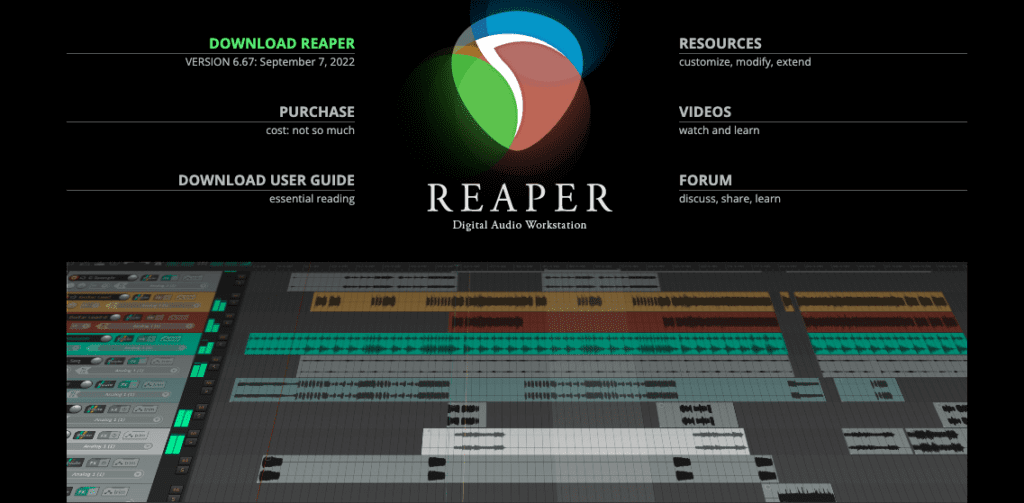
An Audio editing software called REAPER is made for companies in a variety of sectors, including education, non-profit, game development, broadcasting, science and research, sound design, and location recording.
It enables businesses to manage various operations including overdubbing, graphical patch bay emulation, musical articulations, and more on a single platform.
Team members can import, arrange, render, crossfade, resize, loop, cut, split, and mix audio, video, and still image media using Reaper’s drag-and-drop interface.
It enables staff members to record audio at sample rates based on personal preferences and requirements on several CDs and in a variety of audio formats.
Employees may expedite pitch shifting, correction, time stretching, and spatial visualization processes using the transformation tool from a single platform.
Businesses can combine REAPER Audio editing software with a variety of third-party solutions thanks to its API. Employees may integrate plug-ins like ReaXcomp, RealEQ, and RealFIR into track control and mixing panels using the FX plug-in embedding tool.
Key Features of Reaper.
1.Record and edit.
With the Reaper recording program, it is simple to record both audio and (MIDI) Musical Instrumental Digital Interface. Everything can be modified and edited.
There is no limit to how much you can record and edit. Recording different instruments or vocals with REAPER software is not at all challenging.
2.Mixing.
REAPER has a lot to give you, despite the mixer’s initial appearance of being rigid. Instrument and impact parameter automation is quite strong.
Because you can still bounce or freeze tracks while working, it makes no difference if you are employed. The mixer has a lot of versatility.
You may easily construct tracks with REAPER’s mixer by dragging and dropping your recordings. You can even change the arrangements by shifting the pieces around.
3.Interface.
You might find yourself unsure about how to use the interface while looking at it. Some people genuinely enjoy learning new things, like the REAPER Recording Software.
However, other individuals seem least interested since they find the interface’s emptiness confusing.
The ability to modify its interface, though, is what makes it so great. You can customize the software interface with various backgrounds and layouts using REAPER.
4.Powerful stability.
The recording software REAPER is quite stable. In comparison to rival products, this is one of its main advantages.
Rarely do load times and resource usage have an impact on RAM. Additionally, the software supports a huge number of languages. To run the app, choose the language of your choice.
Dislikes for Reaper.
- The software can only be used on one computer at a time, even if licensing keys can be installed on many computers.
- No instruments or loops built in.
- Lacks an intuitive interface, thus difficult to master
- Appropriate for all commercial and home studio digital audio applications.
- No free trial version.
3.Garage Band.

All new Macintosh computers come pre-installed with GarageBand, a Audio editing software and music composer for Mac OS X.
The program allows users to mix several sounds captured from those instruments at the push of a button as well as produce multi-track recordings of themselves playing a variety of instruments.
The music business has seen significant upheaval in the digital age. The true force behind this transformation is a new generation of independent home recording artists.
Musicians now have access to all the tools needed to produce studio-quality recordings at home, including Garage Band, with a basic computer that can be purchased for the same price as or less than a traditional musical instrument.
Additionally, you won’t quickly run out of inspiration thanks to the integrated library’s thousands of royalty-free loops made by top musicians from all over the world!
The ability for musicians to record high-quality sounds at very low costs and without any prior experience or understanding of studio equipment is growing, powered by computer software like GarageBand, for people who don’t have studios!
Key Features of Garage Band.
1.Making Music Projects From Nothing.
With GarageBand, users may make their music from start. This app makes it easy to play the piano, guitar, or drums while creating beats.
Simply play your instrument of choice while pressing the record button. Dragging and dropping various components into place, allows musicians to quickly produce tunes that sound professional.
2.Voiceover Tracking.
You can record your vocals or a voiceover for video projects using the incredibly simple-to-use program GarageBand. Start singing right now by plugging in an external microphone!
The tracks, which are categorized as “instruments” based on their acoustic characteristics, can also be automatically separated, by doing this; users can quickly edit audio files in the future.
3.Rearranging and editing music.
Users of GarageBand can modify their songs with a few quick clicks. Each part of your song may easily be made louder or softer, as well as faster or slower without changing the pitch.
4.Loop implementation.
With GarageBand, musicians may incorporate pre-existing loops into their compositions to produce more complex sounds.
These loops can easily be dragged in from the library and are organized by instrument type. Drums, bass lines, or chords that play when played repeatedly are a few of these.
5.Third-party instruments Downloading.
Users of GarageBand can download external instruments right from the program! If the collection of fundamental sounds is all you have left to offer, this is quite beneficial.
6.Using Effects to Shape Your Sound.
Users of GarageBand can apply several “effects” to their tracks, which can be utilized to produce music with a distinctive sound.
Reverb (echo) and delay settings, as well as filters that change the music’s low- or high-end spectrum, are among these.
Applying these small adjustments effectively can drastically change the way you hear a mix, making it much simpler to realize your musical ideas without having much prior producing knowledge.
Dislikes of GarageBand.
- Available only on Mac.
- Lacks more sophisticated features than other software choices.
4.Ableton Live.

Ableton Live is a strong digital Audio editing software workstation for the creation and live performance of music.
Utilizing a single real-time platform, users of Ableton Live may compose, produce, and perform music. It provides a vast array of instruments, sounds, tools, and loops for composing a wide range of music and sound effects.
Musicians and producers can create music on the platform without using any additional audio editing software because it has a large sound library, plug-ins, and an easy-to-use clip-based interface.
Ableton Live allows users to create a wide range of sounds at any tempo, use a wide range of instruments and sound effects, and much more. Users can also sketch, adjust, and experiment with sounds, organize music in great detail on a timeline, record all ideas, and transform them into music.
Ableton uses cutting-edge technology to enhance the experience of music production and live performance.
Musicians are free to generate ideas and mold their sound, create a creative muddle with analog-modeled noise, or collaborate across many devices. They can continuously play music while simultaneously playing MIDI and audio loops of various lengths.
Key Features of Ableton Live.
1.Recording and Comping Action.
When recording vocals or other instruments, this function makes it simple to get the ideal take. Using “Take lanes,” you may even piece together various passages from many takes to produce something entirely new!
Working with both MIDI and audio, recording with Ableton live is now a breeze no matter your preference.
2.Linked Track Editing.
In music production, pairing two tracks together is fairly typical. Maybe there are two singers singing harmonies. Another option is for two musicians to record a call and response.
You can join two or more songs together and edit them all at once using linked track editing.
Enables options and adjustments across numerous channels, including clip moving, clip fading, clip cutting, etc. another feature that is compatible with both MIDI and audio are linked track editing, which keeps every track in time while you edit.
This allows you to change several instruments at once without changing the session as a whole.
3.Mode for MIDI Scale and Fold to Scale.
With this new feature, Ableton Live MIDI editor will now display the precise notes to utilize when using musical scales as a guide for producing melodies and chords in any key.
Either use the scale as a reference or fold the editor to only display notes in a particular scale.
4.Rack Improvements.
You can now add up to 16 macro controls to a rack or delete macro controls to save up space on the screen.
Macro Snapshots, a fantastic new rack feature in Live, allows you to save preset states of the macro controls that can be switched on-the-fly.
Thanks to macro Snapshoots, the days of writing down knob positions like clock hands or taking a picture of your phone’’ settings so you can recall them precisely in the future are over.
5.Tempo Resulting.
Ableton Live can receive an audio input signal and instantly modify the project’s tempo. This completely alters everything because all of your programmed instruments and sounds may now sync to your external live drumming, clapping, tapping, or anything else keeping time.
Restoring humanity to your digital creations. In your Dj sets and other live performance contexts, live May also functions as a tempo-synchronized loop and sample playback device.
Dislikes of ABLETON LIVE.
- Notation view not available
- There is no pitch repair.
- No track comping.
5.Pro Tools.
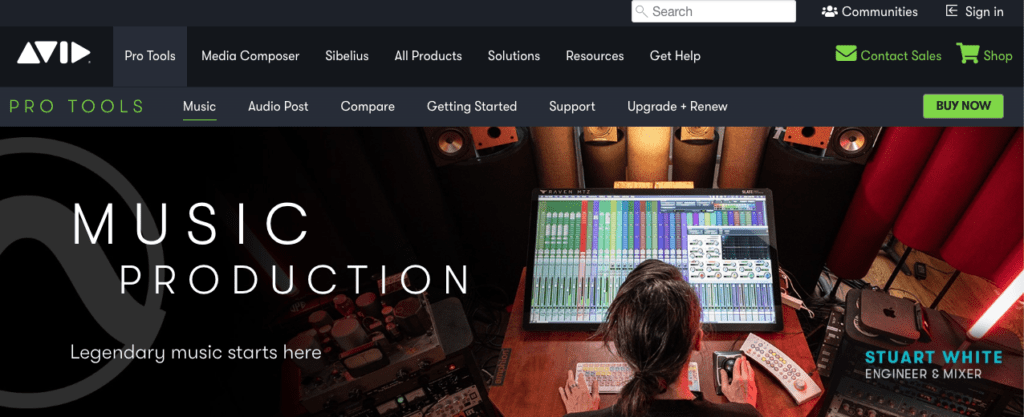
With the aid of the audio editing program Pro Tools, audio professionals, educators, and musicians may record, edit, mix, and create original audio content.
Artists can combine several takes of a recording using the solution, adjust the timing of recordings, and sync audio rhythms in real time.
Teams can optimize soundtracks and cut audio clips to create music using the centralized platform’s editing capabilities. Pro Tools is a tool that operators can use to automate playlist tracking, save presets, and record MIDI performances.
The system enables companies to access a variety of sounds, including guitars, loops, drums, and more to produce song beats.
Additionally, it enables administrators to swiftly switch between plug-ins, alter audio tracks, and treat vocal sounds utilizing nudge notes.
Key Features of Pro Tools.
- Audio editing
Pro Tools is one of the best audio editing programs available. It comes with strong waveform editors, numerous effects plug-ins, and a wide range of MIDI controllers. Any audio segment can be chosen and moved to another track using your mouse.
This saves time and effort because you don’t have to deal with manually dragging individual clips into various tracks.
Another cool feature is the ability to automate any clip inside a project, allowing you to choose how long each sound plays.
You can always import a WAV file into a project and edit the audio yourself if you are looking for something a little bit easier.
- Edits can be made Easily
Making adjustments is simple with Pro Tools, which is one of the main advantages of using it.
The only thing you have to do is click the edit button in the bottom left corner of the window and then select cut, copy, or paste according to your goals.
To go to the next step after making your adjustment, just click Enter to confirm it. Everything is put up properly and there are no difficult menus to browse.
- Audio Mixing and Mastering
Although mixing and mastering are undoubtedly the most crucial steps in creating music, they don’t always have to be done by hand. You don’t have to be concerned about making mistakes when mixing and mastering your music with Pro Tools.
You may easily drag an instrument onto the fader bar and drop it where you want it to be if, for instance, you want to change the volume levels of a certain instrument.
Even individual instruments can be compressed to increase or decrease their volume. Additionally, you may create EQ presets and save them so that you can use them in other projects in the future.
The only drawback is that once the settings have been stored, they cannot be changed. The same is true with adding effects; once they have been used, they cannot be reversed.
- MIDI Control Devices
In addition to editing audio files, Pro Tools also lets you work with MIDI data. Open a MIDI controller plugin, such as the M4L Controller, first to perform this. Then, from a MIDI keyboard or drum machine, you can load up the MIDI notes you want to play.
The MIDI mapping mechanism is then used to assign these notes to the various interface controls.
Pro Tools Dislikes.
- Pricing is now subscription-only.
- Two new additions, but a weak instrument bundle.
6.Ardour.
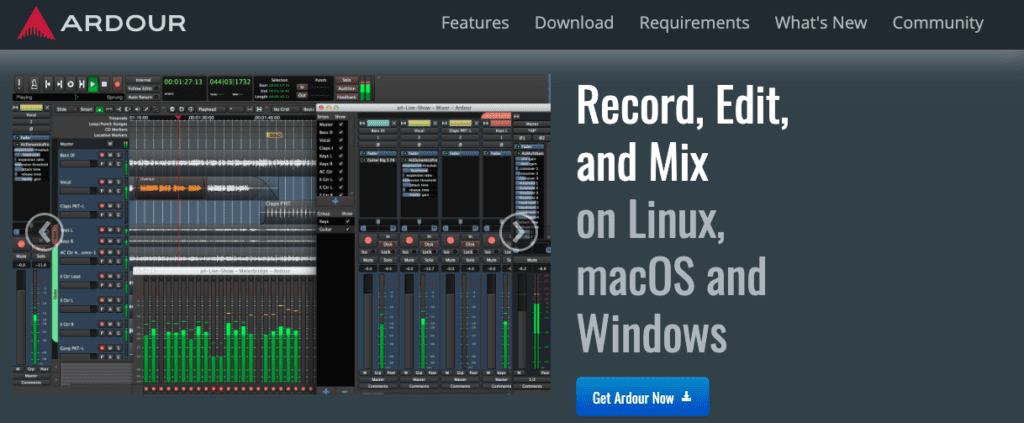
Ardour is on-premise open-soured Audio editing software that enables companies to upload, record, and edit audio snippets on the computer running Linux, macOS, AND Windows. Editors can add blank frames, route multichannel recordings to different mixer strips, and extract soundtracks from imported videos.
Businesses may combine master records and separate tracks with Ardour, undo modifications, and redo them while maintaining video-frame granularity across tracks.
Managers can use the stop and forget feature to halt a recording pass and free up disk space as well as view the frame-by-frame timeline of the video.
Businesses can regulate the fundamental attributes of soundtracks, such as solo, record enables, or mute according to requirements, using the mix groups’ functionality of Ardour. Support is provided online through email and other methods.
Key Features of Ardour.
1.Recording.
You can choose between the PCI, firewire interface, USB, network audio, and other audio interfaces in the Ardour depending on your needs.
Without first setting up the recording, it permits the configurations of each recording as well as any master records.
The Ardour recording lesson is also available to help you learn the basics of recording by monitoring the arming at any given moment.
2.Editing.
The non-linear editing approach provided by the overlapping opaque and transparent zones of the Ardour program gives you limitless undo and redo capabilities.
The push-pull trimming mechanism is accessible to users. With note-based editing, you can also use the rhythm ferret and strip silence.
3.Soundtracks.
The Ardour program also enables you to import a single movie and export it to get the music out of it.
It makes it easier for things to work by enabling cuts, endings, and starts, adding blank frames, and mixing it with the audio of the specific session that is currently functional.
4.Single-channel Tracks.
An infinite number of stereo and mono tracks, as well as multichannel recordings, flexible plug-ins, buses, and panner architecture, are available for your selection.
It also delivers the multi-route channels with a separate output to set it apart from mixer strips created for processing and planning.
5.Mixing.
You can listen to the model via the Ardour software’s optional monitor component, which also supports stereo panning from a plug-in.
The mix groups can be used for both the control tracks’ basic track properties.
6.Compatibility.
Because Ardour is an open-source digital workstation, anyone may study the source codes and learn exactly how, what, and when certain activities take place.
It also abides by numerous rules and regulations that are part of the operations and capabilities.
7.Mastering.
A recorder, editor, or mixer are only some of its features. Instead, all of the methods used in the final form can be employed in the master projects.
It is used for the JACK integration that makes use of the mastering tools as well as for the functionality and accessibility of plug-ins.
8.Plug-Ins.
For the dynamic controls, Ardour uses a variety of plug-ins and turns on FX processing functions. You can edit and add the plug-in to the track to use it.
Ardour Dislikes.
- To use this software, you must have a recording device.
- If you don’t understand the recording concepts, Ardour is a program that is simple to become lost in.
7.FL Studio.
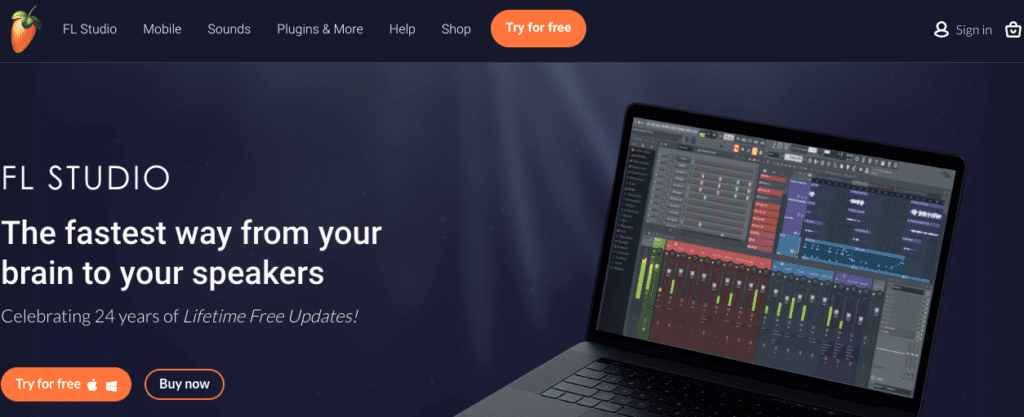
FL Studio is an all-in-one music production Audio editing software that enables musicians and producers to compose, mix, and master music to the highest industry standards.
Users can arrange each track’s components for mastering using drag-and-drop functionality in FL Studio’s Playlist dashboard.
To enhance sound capabilities, FL Studio provides a variety of plugins, synths, and effects through its online store.
FL Studio allows users to integrate any VST plugin by supporting all VST 1, 2, and 3 standards for extra sound capabilities.
The built-in piano Roll allows users to quickly sequence notes to build complicated tunes. An IOS, Android, and Windows app are available for FL Studio on mobile devices.
Key Features of FL Studio.
1.An intuitive user interface.
In comparison to other DAWs (Digital Audio Workstation), FL Studio has one of the most user-friendly interfaces.
Even though it has a lot of features and plug-ins, everything is divided from one another and has enough visual cues so you always know which part or pug-in is which.
Since it enables you to make basic melodies and loops using a pattern-based grid, the Step Sequencer will undoubtedly become one of your closest friends.
2.Designed to turn you become a pro.
FL Studio may appear complicated, but there are lots of tools available to help you learn how to master every feature of this cutting-edge DAW. Additionally, there are a ton of worthwhile materials available online.
3.The Mixer.
All audio passes through the mixer, you may build titles that range from being very basic to being complex thanks to its efficiency and intuitiveness.
Additionally, it enables you to create a variety of complicated compositions, including side chain control, sophisticated automation, plug-in delay compensation, and more.
4.Browser and Playlist.
The playlist panel lets you see where each of the components is played to create the finished song. You may use a tool to quickly compose tracks so they can hold audio, notes, or automation.
You can place any data there to play, overlay, and more. Additionally, the Browser will be quite helpful to you in maintaining organization.
5.Instruments and effects.
FL Studio is compatible with VST 1, 2, and 3, so you can install your preferred plug-ins. You may download and add a ton of wacky and extremely creative plug-ins based on your needs in addition to all the basic functionality.
And last but not least, you may also use FL Studio as a VST (Virtual Studio Technology) instrument inside of another digital audio workstation.
6.FLEX.
Another ground-breaking function of FL Studio is FLEX. It is a preset-based synthesizer with subtractive, wavetable, multisampling, FM, and AM synthesis capabilities.
7.File types.
FL Studio can import and export stereo and mono audio files in MP3, WAV, OGG, and FLAC formats. Additionally, MIDI (Music Instrument Digital Interface) files can be imported and exported.
8.Numerous audio samples.
One of the software’s features, Direct Wave, comes with some audio sample libraries that are ready to be used with FL Studio. It also comes with a ton of loops and presets that will enable you to customize your tunes as you like.
Dislikes for FL Studio.
- For newcomers, the learning curve is rather steep.
- All pricing is for a single license only.
- Audio editors are not included in the entry-level Fruity bundle
8.Descript.

Descript is a transcribe management and video editing program made for companies in a variety of sectors, including marketing, sales, user research, online education, and customer service.
It facilities teamwork by enabling members to offer feedback, make shared folders, leave comments, and keep track of document versions. Employees can upload audio files to Descript to have text transcriptions created automatically and edited on a centralized platform.
Employers can update transcriptions and automatically edit or crop video and audio files as necessary by using the video editing tool.
The ability to add introductions, title cards, captions, transitions, animations, and shapes to movies, photos and GIFs is provided.
Supervisors can make shareable links, look up transcripts, and embed videos on a variety of platforms, including blog articles, how-to guides, and other content management systems.
Key Features of Descript.
- Increase accessibility by using precise, automated transcriptions
One of Descript’s coolest features is its ability to quickly translate what you say into the text as you speak, saving you the time and effort of having to manually type it out after listening to the audio.
Similar rules apply to imported audio, where you can enable transcription and observe Descript’s magic in action in real-time.
It is even more helpful because you can modify the audio and transcript at the same time, just like you would a Word document.
In Google Docs, you may simply delete after clicking anywhere in your vocal track or text transcript to indicate the area you want to change. For accurate, simple editing, Descript can locate and zoom into the audio excerpt for you.
- Use Descript’s Overdub tool to convert text to speech
Although text-to-speech transcription has been around for a while, Descript’s Overdub feature makes it available to everyone.
It can be helpful for a variety of things, like correcting minor errors and providing additional information when recording s not an option.
- Export your podcast quickly to Captivate
Once you have edited your audio and transcript in Descript, you can easily export from Descript to captivate by clicking a button thanks to a really smart integration.
You will save time and have a much simpler procedure and workflow as a result.
- Promote podcast episodes by utilizing Descript’s Audiogram and Subtitle Features.
A podcaster’s best friend when it comes to promoting your episodes is audiograms and captioned video content.
They are concise, visually appealing, and can help listeners decide whether or not to tune in to your podcast before they even start.
The creation of audiograms is often a process that follows recording and publishing, but because of Captivate’s interaction with Descript, you may do it while still in the Descript dashboard. You will spend a lot less time and effort doing this.
- Edit episodes of a live podcast, with a click of a button
Integration between Captivate and Descript simplifies some aspects of podcasting considerably.
From the dashboard of captivating, you can quickly edit live podcast episodes in Descript without affecting your listenership or download statistics. This is a useful function since it allows you to update information that is outdated or inaccurate, remove outdated content, and fix any recording errors.
Descript Dislikes.
- More “accents” and “language modifications” may be required during transcription.
- Video editing takes a lot longer than you might think.
9.Twisted Wave.
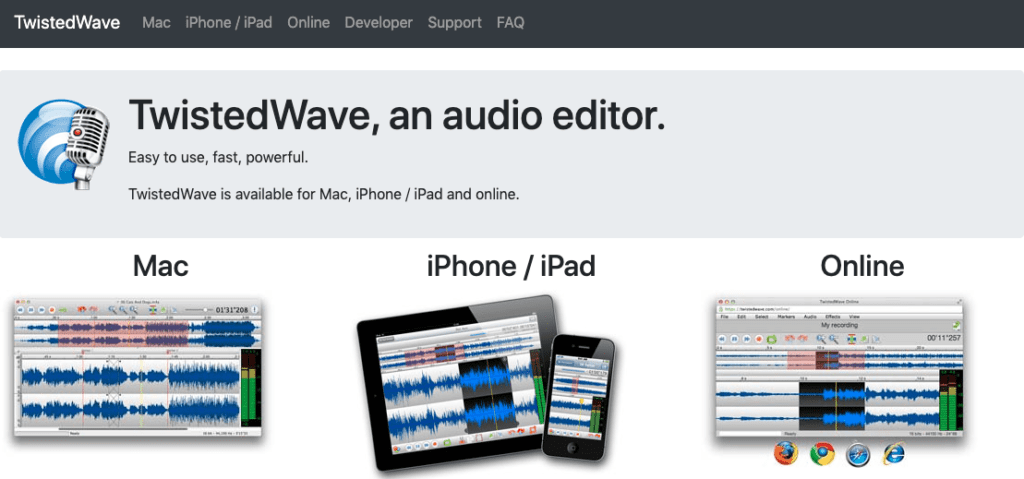
A sophisticated and incredibly user-friendly audio editor called Twisted Wave. It supports a wide range of file formats, including WAV (Waveform Audio File Format), AIFF (Audio Interchange File Format), caf, mp3, mp4, FLAC, Ogg/Vorbis, and ambiguous sound files, as well as audio unit plug-ins. dependable multi-channel support It makes it simple to create, remove, or reorder channels.
Due to its powerful toolkit, Twisted Wave Audio Editor has made a unique appearance in the audio editing section.
This tool is a combination of several effective and necessary features, as you may have been interested in learning more about it. Multiple tools are available across this product, from audio recording to audio mastering.
An instrument for Mac users is this audio editor. Twisted Wave Audio Editor has made sure that you have access to the greatest tools and experience in audio editing although there is not enough diversity in the market for Mac users.
Ideal applications for Twisted Wave include:
1.Recording.
Press record after opening Twisted Wave. A podcast, song, or live performance can be easily started. Utilize a key to highlight specific areas during recording so you can recall where you need to edit. This is a helpful tool for artists.
2.Grasp.
You will undoubtedly find the ideal Audio Unit or VST (Virtual Studio Technology) plug-in among the hundreds of options to achieve the finest results. Equalization, compression, limiting, you choose.
3.Transform files.
Several different file types can be read and written by it. It’s simple to switch one audio file, or even a whole folder, between formats.
4.Batch-process a lot of files.
Twisted Wave automatically cuts, applies fade-in and fade-out, equalizes, and converts sound files to mp3 or any other format when you enter a list of sound files into it.
Features of Twisted Wave.
1.Edits.
Anytime you make changes to the audio, you have the option to go back and make those changes again. Users of the program are free to undo any edits they’ve previously made. Without a doubt, this is outstanding.
2.High Resolution and Sampling Rates.
The instrument is of high caliber. It operates with a resolution of up to 24-bit and a sample rate of 192 kHz, effectively giving its users high-quality audio. Isn’t this fantastic?
3.Large File Format Support.
Support for a variety of audio plug-ins and formats. You will have the finest experience using Twisted Wave Audio Editor because it supports a wide range of formats, including WAV, AIFF, CAF, MP3, MP4, and FLAC (Free Lossless Audio Code).
4.No Process loading.
Because the tool always works in the background while an effect is used. It never interferes with how the user works, which is simply amazing.
5.High Refresh Rate.
Waveforms are updated at 100 frames per second, which is more than most audio editors can handle. The tool has a quick user interface and provides a great working environment!
6.Dependable multi-channel support.
It makes it simple for you to create, remove, or rearrange channels. Additionally, you can apply audio units to multi-channel files or particular channels.
Twisted Wave Dislikes.
- Compared to other audio editors, the interface isn’t all that sophisticated.
- Concerning the features it offers, the tool is pricey.
Summary.
Choosing the best Audio editing software will not only help you cut costs but also produce the best Audio music or sound.All you need to do is read the above software and select the one that suits your needs.







